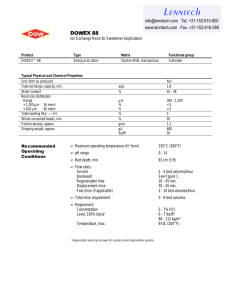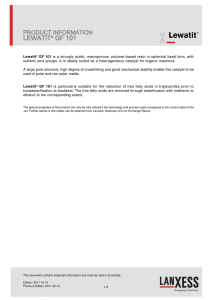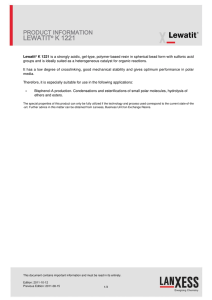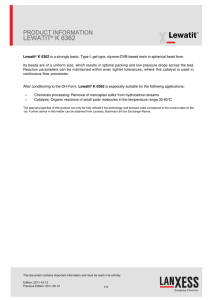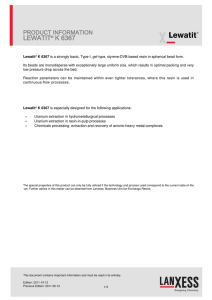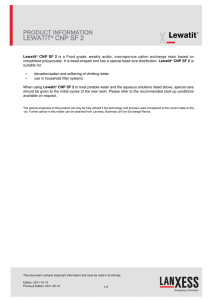DOWEX Lenntech Tech Facts Regenerating Strong Acid Cation Resins with Sulfuric Acid
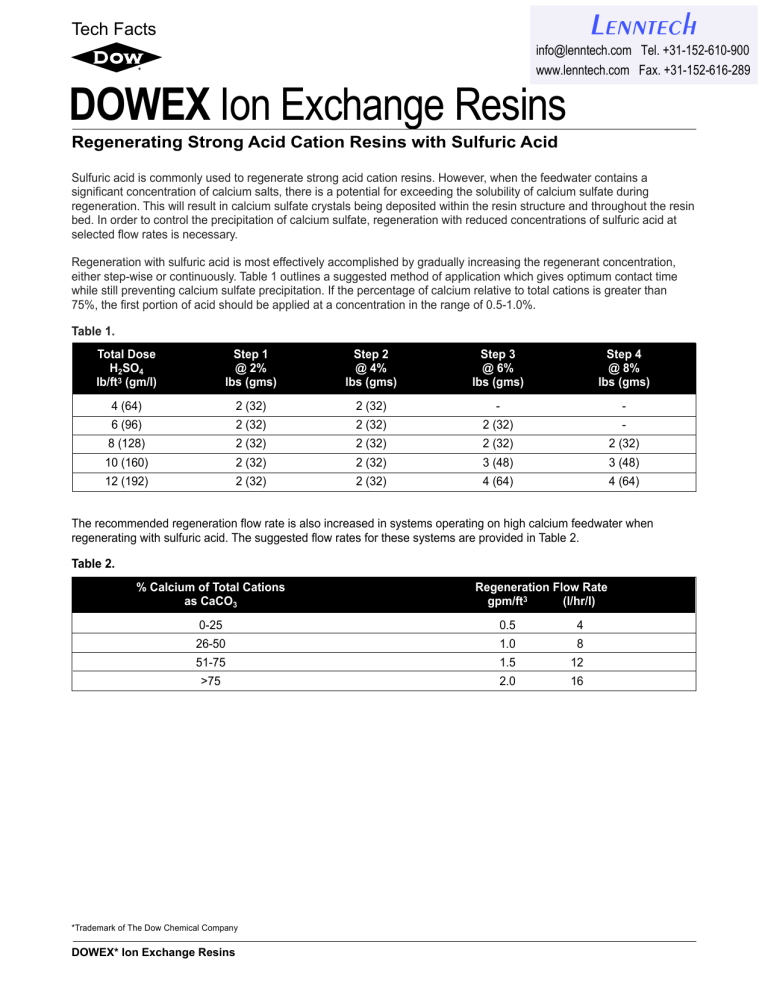
Tech Facts
Lenntech
info@lenntech.com Tel. +31-152-610-900 www.lenntech.com Fax. +31-152-616-289
DOWEX Ion Exchange Resins
Regenerating Strong Acid Cation Resins with Sulfuric Acid
Sulfuric acid is commonly used to regenerate strong acid cation resins. However, when the feedwater contains a significant concentration of calcium salts, there is a potential for exceeding the solubility of calcium sulfate during regeneration. This will result in calcium sulfate crystals being deposited within the resin structure and throughout the resin bed. In order to control the precipitation of calcium sulfate, regeneration with reduced concentrations of sulfuric acid at selected flow rates is necessary.
Regeneration with sulfuric acid is most effectively accomplished by gradually increasing the regenerant concentration, either step-wise or continuously. Table 1 outlines a suggested method of application which gives optimum contact time while still preventing calcium sulfate precipitation. If the percentage of calcium relative to total cations is greater than
75%, the first portion of acid should be applied at a concentration in the range of 0.5-1.0%.
Table 1.
Total Dose
H
2
SO
4 lb/ft 3 (gm/l)
4 (64)
6 (96)
8 (128)
10 (160)
12 (192)
Step 1
@ 2% lbs (gms)
2 (32)
2 (32)
2 (32)
2 (32)
2 (32)
Step 2
@ 4% lbs (gms)
2 (32)
2 (32)
2 (32)
2 (32)
2 (32)
Step 3
@ 6% lbs (gms)
-
2 (32)
2 (32)
3 (48)
4 (64)
Step 4
@ 8% lbs (gms)
-
-
2 (32)
3 (48)
4 (64)
The recommended regeneration flow rate is also increased in systems operating on high calcium feedwater when regenerating with sulfuric acid. The suggested flow rates for these systems are provided in Table 2.
Table 2.
% Calcium of Total Cations as CaCO
3
0-25
26-50
51-75
>75
Regeneration Flow Rate gpm/ft 3 (l/hr/l)
0.5 4
1.0 8
1.5 12
2.0 16
*Trademark of The Dow Chemical Company
DOWEX* Ion Exchange Resins
DOWEX
Ion Exchange Resins
Lenntech
info@lenntech.com Tel. +31-152-610-900 www.lenntech.com Fax. +31-152-616-289
Warning: Oxidizing agents such as nitric acid attack organic ion exchange resins under certain conditions. This could lead to anything from slight resin degradation to a violent exothermic reaction (explosion). Before using strong oxidizing agents, consult sources knowledgeable in handling such materials.
Notice: No freedom from any patent owned by Seller or others is to be inferred. Because use conditions and applicable laws may differ from one location to another and may change with time, Customer is responsible for determining whether products and the information in this document are appropriate for Customer’s use and for ensuring that Customer’s workplace and disposal practices are in compliance with applicable laws and other governmental enactments. Seller assumes no obligation or liability for the information in this document. NO WARRANTIES ARE GIVEN;
ALL IMPLIED WARRANTIES OF MERCHANTABILITY OR FITNESS FOR A PARTICULAR PURPOSE ARE EXPRESSLY EXCLUDED.
Published June 1998.
* Trademark of The Dow Chemical Company
Form No. 177-01760-698QRP
CH 171-460-E-698
